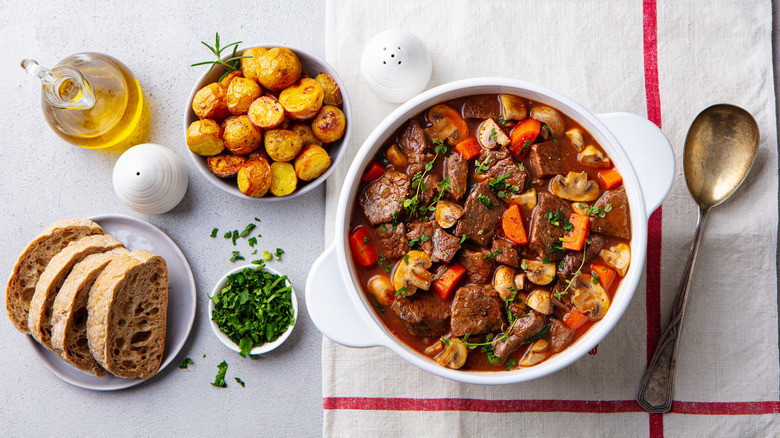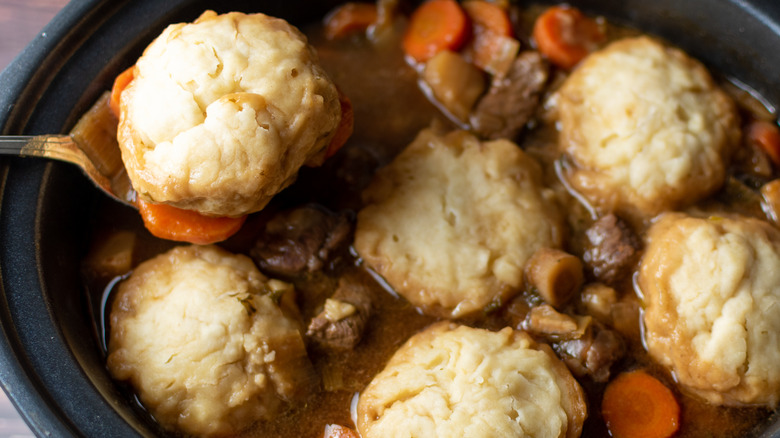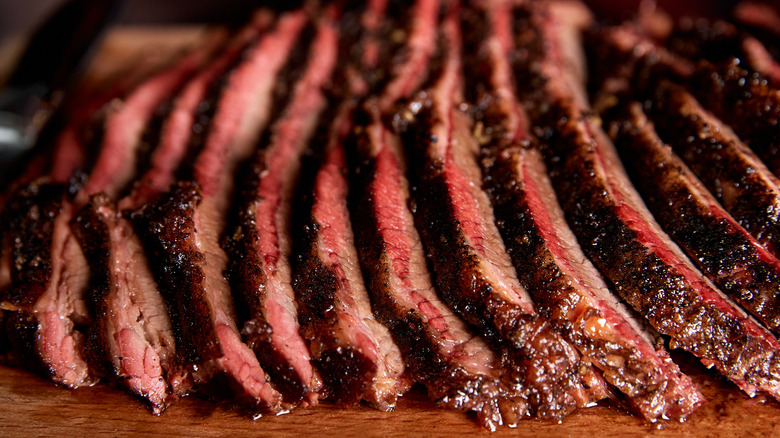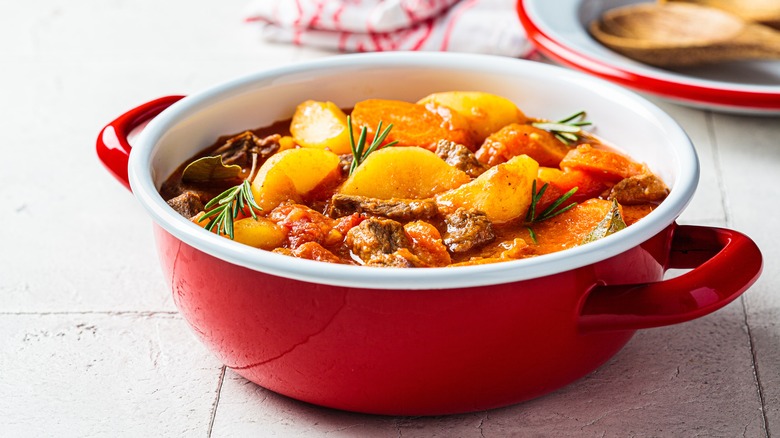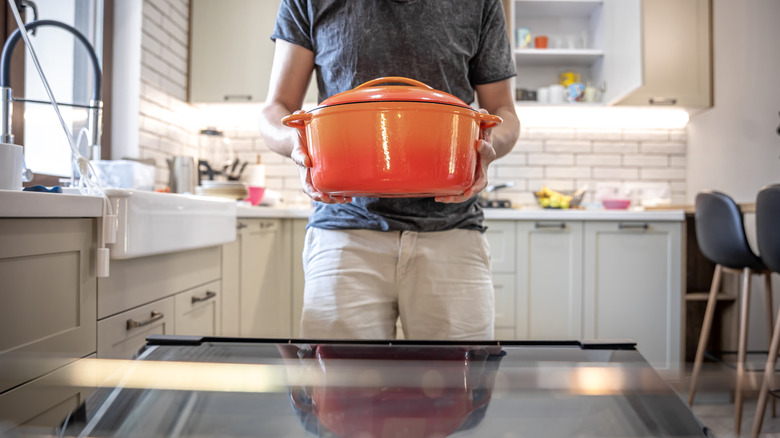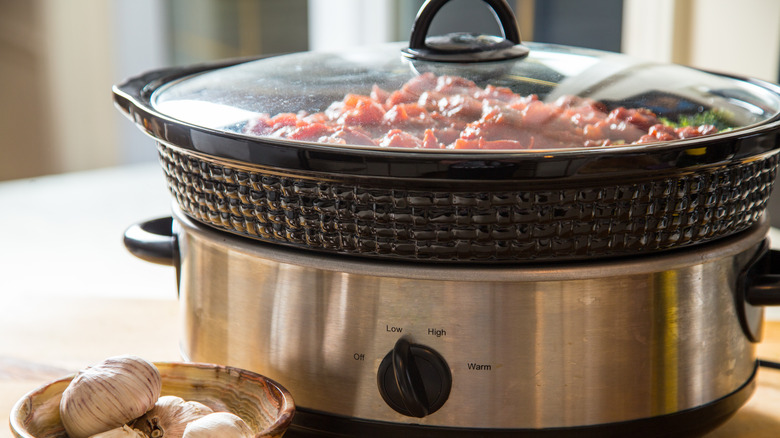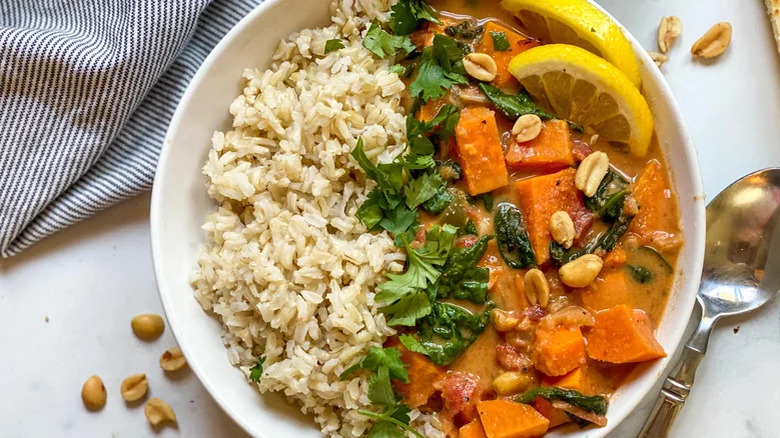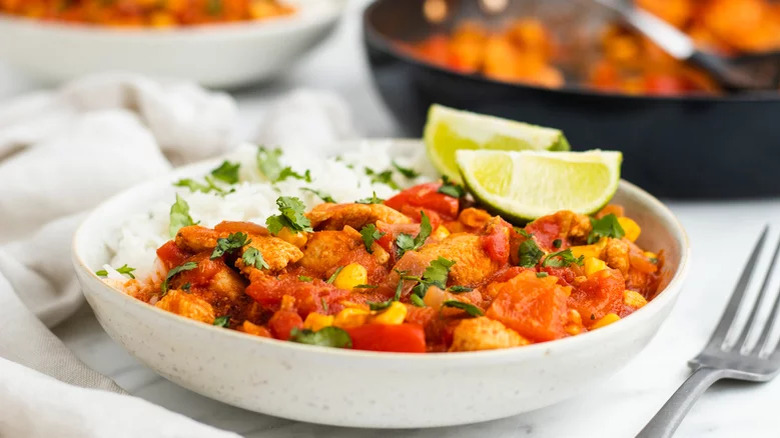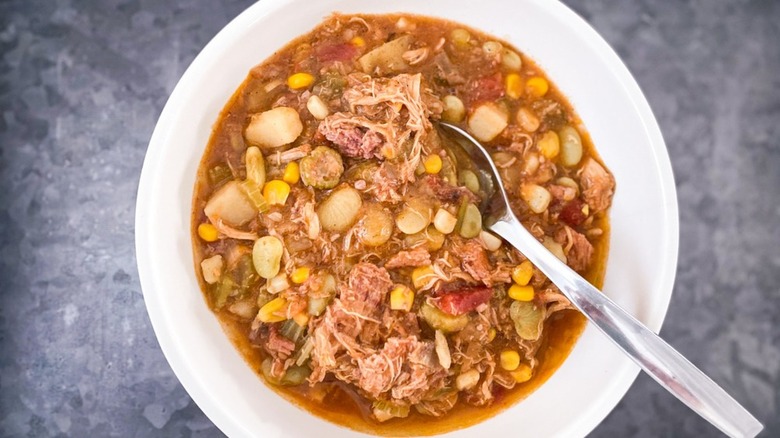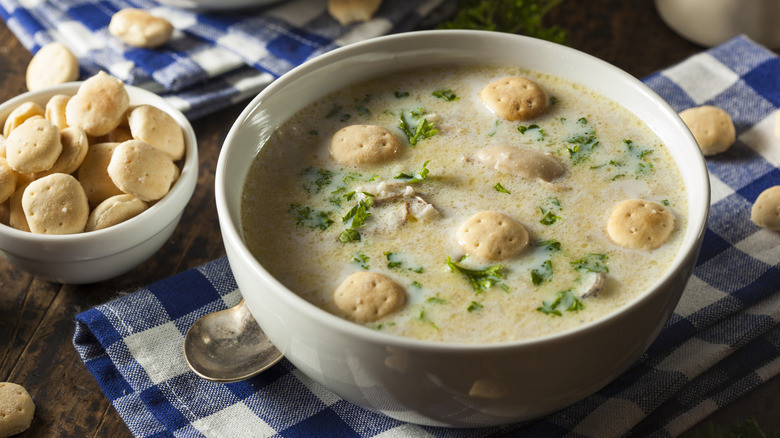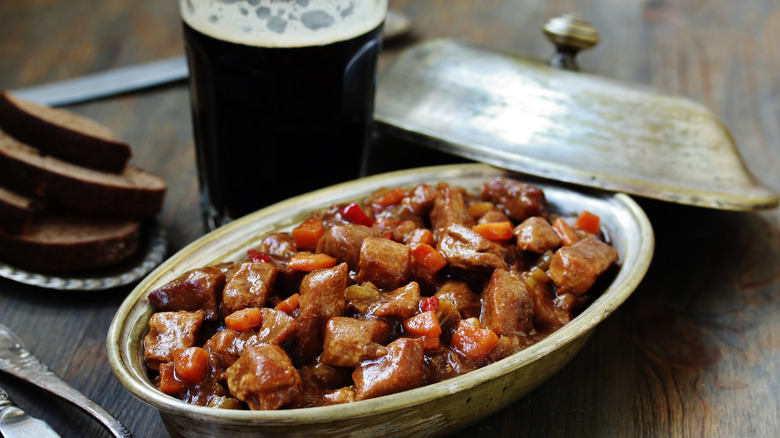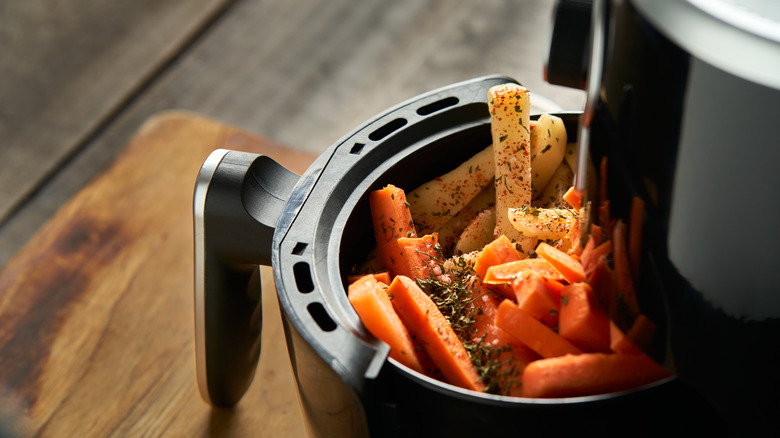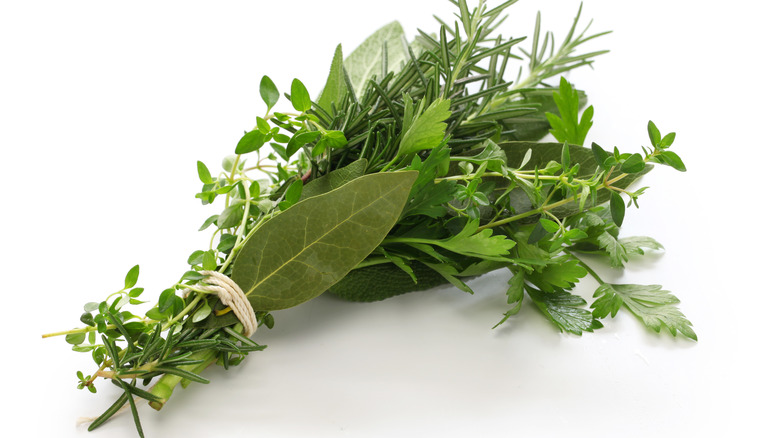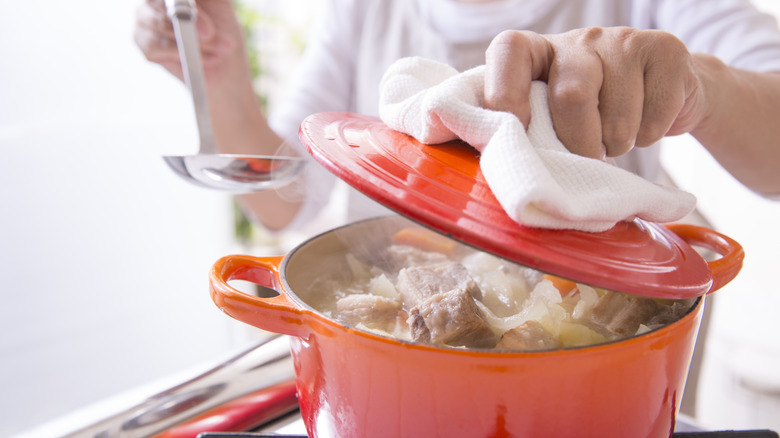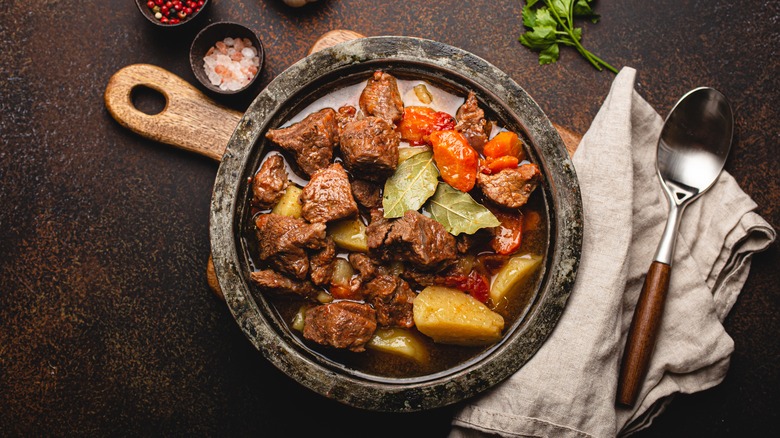Every Way To Cook Stew
When it's winter, chilly outside, or you just need to feel some foodie love, then it's time for a stew. It's a classic dish that's nourishing comfort food at its best. Enjoy hearty beef stew with melt-in-the-mouth meat. Savor flavorful root vegetables that make you feel all warm and cozy inside. And if you're feeling up to some extra time in the kitchen, you can make things as fancy as you want, perhaps with the addition of a nice wine.
Even if you've got a favorite stew recipe to turn to, you might want to consider new tricks like adding a secret ingredient or using a different meat. There are also different alcohols that you can add to stew, as well as ways to make your dish go further. And what about adding some new twists with spices, herbs, or even dumplings? Here is every way you can cook stew.
Cook dumplings in the stew pot
There's arguably nothing better to serve in rich stews than some balls of carb-tastic stodge. Dumplings are the bomb, whether they're. Eastern European dumplings or Asian style. When you've got a thick stew simmering away, these soft doughy bites soak up all the juices and meaty flavors. Traditionally, stew dumplings are made by combining flour and suet, which is beef fat. This creates that unmistakable fluffy and light dumpling texture (via The Guardian). You can also use vegetarian suet (via Great British Chefs).
For a suet-free version, you might also want to try our creamy chicken and dumplings. The dough is made with flour, baking powder, milk, and melted butter. Cook the dough in spoonfuls at the top of the stew so that they're bobbing in the sauce but not fully immersed. As they cook, they'll expand and you want them to be separated so that you can easily spoon them out with each serving. Dumplings in stew are as wonderfully down to earth as dunking a hunk of bread into a bowl of soup.
Use precooked brisket
However you cook stew, and whatever meat and vegetables you use, the fact remains that you make a stew by cooking the ingredients over a long period. You don't need to be a culinary whizz to know that this means leaving your pot of goodies simmering on low heat for a while. Stew is a Sunday favorite. You get up and after a leisurely breakfast, you listen to the radio as you chop carrots and brown meat before lazing with the weekend papers. By dinner, it's time for an end-of-weekend glass of vino and a warming bowl of tenderness. Sounds great, but If you don't have oodles of time then you can speed the process up (via Certified Hereford Beef).
To make beef stew you usually need time for the meat to tenderize and all the juices permeate the rich gravy. The general idea is that the longer you leave your pot stewing, the better. But there's a way to an even simpler, no-fuss dish. The secret is to use beef that's already cooked. Try buying already-cooked brisket or make enough in a pot roast that you've got some left over. You can also add steak or perhaps some shredded or pulled meat that's remaining after a fajita dinner. Cut the brisket against the grain and add to the other ingredients for a meal that's ready in less than an hour.
Use potatoes if there is not enough meat
How much meat should you consume in a day? In terms of red meat, like beef and lamb, that's ideally 1.8 ounces, or 51 grams. When it comes to poultry, that goes down to 1.5 ounces. Seafood's even lower, at 0.4 ounces per day (via SFGate). With this in mind, you might want to balance your stew out with some other nutritious ingredients.
Diet considerations aside, you might also want to bulk out your stew because you've not got enough meat to go around. Perhaps family or friends have dropped by and you've suddenly got more hungry mouths to feed. Or perhaps you're budgeting and want a greater variety of fresh food for less. You can also add some potatoes to a stew so you can stretch its use to a second day. You might also throw in some lentils, turn the stew into a pasta sauce, or even use leftover stew as a savory pie filling.
Decide whether to use the stove or oven
Generally speaking, you can cook a stew on the stove or in the oven. The choice might come down to practicalities, such as whether you need to keep one method free for other dishes. Or it might be decided upon because of the pots and pans that you have to use. While a stew in the oven gets it out the way, a stovetop stew is easier to keep an eye on as you just need to lift the lid and take a peek, topping up with liquid if necessary and giving your culinary cauldron a good stir from time to time.
Commentors on Stack Exchange note that cooking on the stove can be preferable if you want to thicken a stew via evaporation. A stew in the oven is less likely to do so, especially with a lid. You can also start on the stovetop and then complete stewing in the oven. On the stove, the stew at the bottom of the pan might burn if you don't stir enough too, and on a hot day, it may add extra heat to an already steaming kitchen. Foods Guy states that stews are cooked with more liquid than casseroles, for longer, and are ultimately best cooked on the stove.
Cook in a slow cooker or pressure cooker
If you own a slow cooker or pressure cooker, you may be wondering how each would handle a simmering stew. The main difference between the two is really about time. Ideal Home notes that a stew can cook quite quickly in a pressure cooker. With this kitchen device, you can decide you feel like stew and, with the right ingredients, get one ready within 30 minutes.
A slow cooker is the opposite end of the spectrum, with a key clue in the name. This gadget lives up to its name, as a stew made in one will take hours to cook. However, this doesn't have to be a bad thing. If you want to busy yourself with other activities, knowing you'll have a rich stew to look forward to later in the day, then this could be preferable. Of course, not everyone is organized enough or able to get all the ingredients ready up to eight hours before they eat. Choosing between these two is perhaps less about taste and more about what's convenient when you've got a craving for stew.
Stew veggies for a vegan dish
If you love beef that falls apart in a stew then you might not be bowled over by a meat-free bowl of this hearty winter warmer. However, don't dismiss a vegetarian stew just yet. Success here is all about choosing the right combination of ingredients. The key is to include a vegetable that's robust enough to withstand the long stewing process, so you don't end up with a thick soup or a bowl of mush.
You don't have to limit yourself to just one tradition, either. Stew is ubiquitous, meaning there's a variety of this dish pretty much everywhere in the world. Forget meat and potatoes in gravy for a moment and open your Dutch oven to our West African peanut stew. The filling part of this recipe is sweet potato. Add fire-roasted tomatoes and spinach for a vibrant burst of color and silky texture. Fry spices, onions, garlic, ginger, and jalapeño to elevate this stew, which happens to be vegan. You're not going to miss the meat in the slightest once you bite into those soft sweet potatoes.
Add some spice
Most traditional stews are flavorful because of how stewing the meats infuses the broth with tasty juices. You might also add a few herbs or some classic herby dumplings. What you're probably not expecting from a stew is some heat. While classics like French coq au vin or beef bourguignon are delightful, what's extra fabulous about stew is that there are no limits to how you bring the flavor.
Give your stew some spicy zing with our Mexican chicken stew. If you've never thought of serving your next stew with rice, wedges of lime, and cilantro then maybe it's time to try a new way. The flavor here comes from a combination of chili powder, paprika, cumin, oregano, and ground coriander. Check out our green chili chicken stew for another way to add some heat. If you're feeling extra creative, think of a spicy cuisine you like and see if you can find a stew recipe from that region or even create your own.
Stew meats other than beef
If you picture a stew, then chances are that you're seeing tender pieces of beef in a rich brown broth, perhaps with some carrots and other vegetables, as well as some pillowy dumplings. When it comes to cooking, you might have this stew down so pat that you don't even need a recipe. Yet beef isn't the only protein you can use here. The truth is that there are plenty of meats that stew to silky-soft perfection.
A classic that results in tender perfection is our Irish stew, which uses shoulder of lamb. A good tip is to stew lamb at a low heat setting so that any fat rises to the surface and can be skimmed off. Otherwise, the stew may become unpleasantly greasy. Low heat also works well, as lamb tends to cook more quickly than some other proteins. Another option is our Brunswick stew made with shredded chicken and pulled pork.
Follow tradition with an oyster stew
You may be familiar with the concept of a seafood stew. It may sound so good that you're ready to try our Spanish-style fish stew made with tomatoes, chickpeas, black olives, cod, and chorizo, plus cayenne pepper and paprika for a bit of a kick. In certain regions of the U.S., especially the East Coast, it's traditional to use oysters.
Part of the tradition of oyster stew relates to its place in the cuisine of Irish immigrants who made their way to the U.S. and began integrating their homeland's foodways into American cuisine (via The Recorder). If you're an oyster fan and want to try a stew that's a little different, then make sure you use some of the salty brine that comes along with the oysters. Using this helps to elevate the seafood flavor of the creamy stew. Want to amp up that texture and flavor? Add some butter, too.
Add alcohol to the stewing liquids
You don't have to add alcohol to a stew, but it helps! Some stews call for a hearty, full-bodied wine such as Pinot Noir in beef bourguignon. Meanwhile, a coq au vin made with chicken demands red wine, too, and perhaps a splash or two of Cognac. Meanwhile, seafood stews are more likely to suggest white. But why stop there, especially since there are so many great ways you can cook with alcohol? Consider other food traditions outside your own if you need some inspiration. For example, in Belgium and some parts of France, a beef stew known as carbonnade is made with beer (via The Washington Post).
You might want to make a carbonnade using a Belgian-style beer and serve it with wide, velvety noodles. Add the beer just before the stew cooks in the oven and begins to caramelize the onions. A hearty stout like Guinness can likewise take your stew to the next level by deepening the color, adding a malted barley aroma, and giving your stew a delightfully toasted taste.
Cook stew in an air fryer
When you consider it, there are plenty of pots and pans you can use to cook a stew. You may prefer a saucepan on the stovetop or a Dutch oven in the hotbox below. You can also turn to using your slow cooker or, if time's short, a pressure cooker. However, we're not done yet. There is another option, suggested on TikTok, that you might not have considered: the air fryer. It seems that there is practically nothing you can't do with this game-changing piece of kitchen kit.
There's only one way to find out how this method really cooks stew compared to others: try it yourself. Add veggies to your air fryer's basket. TikTokker @airfry_jen suggests carrots, broccoli, and Brussels sprouts. Add seasonings and beef, then cover with water. Use the roast setting, taking a minute to stir it all partway through cooking.
This use of an air fryer may seem unconventional, but it has its potential uses. If your oven is full because you're making other goodies to go with your stew, this could be very handy indeed.
Make your own bouquet garni
Check out any stew recipe and, along with the main ingredients such as meat, vegetables, and stock, you'll soon learn that herbs play an essential role in creating a stew's flavor. While you may want to sprinkle those herbs in bits and pieces, if you're making stock or flavoring a stew, there's another way that allows you to add flavor without leaving in stems and leaves, known as a bouquet garni. This is a selection of fresh herbs that have been tied together or encased in a cotton muslin bag. With this method, you simply add the bundle to the pot, let the flavors infuse throughout the stew, and then take it out before serving.
You can use budget-friendly dried herbs in a bouquet garni, although you'll definitely need to put them in a muslin or cheesecloth bag to keep everything contained. Dried herbs can also help to create a more intense flavor. Dried or not, if you want the flavors of herbs like rosemary or thyme without actually eating the stems or other bits, a bouquet garni is ideal. Try different herbs together and create your signature bouquet.
Discover secret ingredients
If you follow recipes for a few commonly recognized stew classics, you'll soon find variations even in tried-and-true versions, including ingredients, timing, and techniques. However, the chances are that most will follow generally the same culinary path, without much deviation. These dishes have been tried and tested to create just the right balance of taste and texture. That doesn't mean that you can't discover secret ingredients that promise a new way of cooking stew.
Food.com suggests a stew ingredient that you've probably never thought of adding: Italian dressing. You're still going to fry the meat to seal it to make a beef stew before adding stock, tomatoes, and herbs. The only difference is that you add ½ cup of Italian seasoning to 32 ounces of stewing steak when you brown it in the pan.
TikToker @rotundchef also adds an interesting stew ingredient. After frying beef and onions, add parsnips, celery, carrots, peppers, and red potatoes. That's followed by white wine, Worcestershire sauce, and fresh thyme. Then you're going to add a real flavor booster with a dry onion soup sachet. It may seem simple, but this quick add-in will lend some serious flavor that can keep diners guessing in the best way.
Use quick-cooking meats
Stewing meats can take hours, largely because the cut of meat that's usually used to make a beef stew isn't the same as what you'd cook if you were looking to enjoy a steak. Stewing breaks the meat down so that you get a soft, fall-apart texture. However, there's a great way to use fresh meat that doesn't take quite so long. Simply try our 30-minute lamb stew. You can also use ground beef here. Once you've browned the meat and added the other ingredients the rest of the stew only needs a 20-minute simmer. Why? Because you're using ground lamb instead of cuts that need to break down slowly.
Try a similar TikTok hamburger stew by frying minced garlic with ground beef. Add bone broth, a can of tomato soup, chopped tomatoes, and potatoes, plus a dash of Worcestershire sauce and some Italian herb seasoning. Throw in a couple of bay leaves, simmer and that's it. Or you might craft a Lebanese-style ground beef stew made with spinach, lemon juice, garlic, and cilantro (via TikTok). What about a Korean stew suggested by @chungeats on TikTok? Make it with Spam, enoki mushrooms, and green onions, as well as tofu, gochujang, soy sauce, gochugaru chili powder, and garlic. Add ingredients like kimchi, hotdogs, and ramen noodles before simmering to perfection.
